Crop Residue Removal: Assessment of Future Bioenergy Generation Potential and Agro-Environmental Limitations Based on a Case Study of Ukraine
Abstract
1. Introduction
2. Methods and Materials
2.1. Modeling Ukraine’s Agricultural Development
2.2. Methods for Evaluating the Environmental Limitations to Removal of Crop Residues
2.3. Energy Potential of Crop Residues
- (a)
- theoretical potential:
- (b)
- technical potential:
- (c)
- economic potential:
- a general declining trend in demand for straw for livestock production purposes;
- distribution inequalities in the regional concentration of specialized livestock enterprises;
- improvement of livestock production technologies, leading to the reduced use of biomass as bedding.
- increased costs of weed (15–100%) and pest (by two to three times) control;
- lower seed germination, requiring increased seeding rates (by 15–25%);
- higher price of equipment for direct seeding;
- higher fire hazard due to the presence of crop residues on the soil surface;
- need to control the application of additional doses of mineral fertilizers (phosphorus, nitrogen) under certain conditions.
2.4. Data Sources
3. Research Results
3.1. Background: Ukrainian Agriculture and Its Transformation
3.2. Projection for the Development of Selected Crops’ Cultivation by 2030
3.3. Assessment of Crop Residues’ Availability Based on Agro-Environmental Limitations
- declining share of roughage in livestock feed;
- a reduction in the use of straw for bedding due to the increasing use of alternative materials (e.g., rubber, sawdust).
3.4. Bioenergy Generation Potential (National and Regional)
4. Discussion
5. Conclusions
Author Contributions
Funding
Conflicts of Interest
References
- The Energy Strategy of Ukraine until 2035 “Safety, Energy Efficiency, Competitiveness”; Cabinet of Ministers of Ukraine: Kyiv, Ukraine, 2017. Available online: https://zakon.rada.gov.ua/laws/show/605-2017-%D1%80 (accessed on 20 August 2020).
- Energy Supply Based on Renewable Sources; State Statistics Service of Ukraine: Kyiv, Ukraine, 2019. Available online: http://www.ukrstat.gov.ua/operativ/operativ2016/sg/ekolog/ukr/esp_vg_u.htm (accessed on 2 August 2020).
- Bioenergy Association of Ukraine. Available online: https://uabio.org/en (accessed on 7 September 2020).
- Geletuha, G.G.; Zheliezna, T.A.; Dragniev, S.V. Analysis of Barriers in Production of Energy from Agrobiomass in Ukraine: Analytical Report; BAU: Kyiv, Ukraine, 2019; Volume 21, Available online: https://saf.org.ua/library/198 (accessed on 22 July 2020).
- Iqbal, Y.; Lewandowski, I.; Weinreich, A.; Wippel, B.; Pforte, B.; Hadai, O.; Tryboi, O.; Spöttle, M.; Peters, D. Maximising the Yield of Biomass from Residues of Agricultural Crops and Biomass from Forestry; Ecofys: Berlin, Germany, 2016; Available online: https://ec.europa.eu/energy/sites/ener/files/documents/Ecofys%20-%20Final_%20report_%20EC_max%20yield%20biomass%20residues%2020151214.pdf (accessed on 22 July 2020).
- Puri, M.; Rincon, L. Egypt, Turkey and Ukraine: Sustainable Bioenergy Options from Crop and Livestock Residues; FAO: Rome, Italy; EBRD Crop.: London, UK, 2017; Available online: http://www.fao.org/3/a-i8150e.pdf (accessed on 11 August 2020).
- Bioenergy in the Global Energy Context. GBEP: Global Bioenergy Partnership; FAO: Rome, Italy, 2007; Available online: http://www.fao.org/3/a1348e/a1348e02.pdf (accessed on 22 July 2020).
- Reid, W.V.; Ali, M.K.; Field, C.B. The future of bioenergy. Glob. Chang. Biol. 2019, 26, 274–286. [Google Scholar] [CrossRef] [PubMed]
- Dhanya, B.S.; Mishra, A.; Chandel, A.K.; Verma, M.L. Development of sustainable approaches for converting the organic waste to bioenergy. Sci. Total Environ. 2020, 723. [Google Scholar] [CrossRef] [PubMed]
- Kaltschmitt, M. Biomass as renewable source of energy, possible conversion routes. In Encyclopedia of Sustainability Science and Technology; Meyers, R.A., Ed.; Springer: New York, NY, USA, 2012. [Google Scholar] [CrossRef]
- Maltsoglou, I.; Koizumi, T.; Felix, E. The status of bioenergy development in developing countries. Glob. Food Secur. 2013, 2, 104–109. [Google Scholar] [CrossRef]
- DeCicco, J.M.; Schlesinger, W.H. Opinion: Reconsidering bioenergy given the urgency of climate protection. Proc. Natl. Acad. Sci. USA 2018, 115, 9642–9645. [Google Scholar] [CrossRef] [PubMed]
- How2Guide for Bioenergy; IEA: Paris, France; FAO: Rome, Italy, 2017; Available online: http://www.fao.org/3/a-i6683e.pdf (accessed on 6 August 2020).
- Fischer, G.; Schrattenholzer, L. Global bioenergy potentials through 2050. Biomass Bioenergy 2001, 20, 151–159. [Google Scholar] [CrossRef]
- Van Vuuren, D.P.; van Vliet, J.; Stehfest, E. Future bio-energy potential under various natural constraints. Energy Policy 2009, 37, 4220–4230. [Google Scholar] [CrossRef]
- Ladanai, S.; Vinterbäck, J. Global Potential of Sustainable Biomass for Energy; Sveriges Lantbruksuniversitet (SLU): Uppsala, Sweden, 2009; Available online: https://pub.epsilon.slu.se/4523/1/ladanai_et_al_100211.pdf (accessed on 22 July 2020).
- Kappas, M. Estimation of global bioenergy potentials and their contribution to the world’s future energy demand—A short review. In Sustainable Bioenergy Production—An Integrated Approach; Ruppert, H., Kappas, M., Ibendorf, J., Eds.; Springer: Dordrecht, The Netherlands, 2013. [Google Scholar] [CrossRef]
- Deng, Y.Y.; Koper, M.; Haigh, M.; Dornburg, V. Country-level assessment of long-term global bioenergy potential. Biomass Bioenergy 2015, 74, 253–267. [Google Scholar] [CrossRef]
- Usmani, R.A. Potential for energy and biofuel from biomass in India. Renew. Energy 2020, 155, 921–930. [Google Scholar] [CrossRef]
- Streimikiene, D.; Mikalauskiene, A.; Mikalauskas, I. Comparative assessment of sustainable energy development in the Czech Republic, Lithuania and Slovakia. J. Compet. 2016, 8, 31–41. [Google Scholar] [CrossRef]
- Gradziuk, P.; Gradziuk, B.; Trocewicz, A.; Jendrzejewski, B. Potential of straw for energy purposes in Poland—Forecasts based on trend and causal models. Energies 2020, 13, 5054. [Google Scholar] [CrossRef]
- Poppa, J.; Lakner, Z.; Harangi-Rákos, M.; Fári, M. The effect of bioenergy expansion: Food, energy, and environment. Renew. Sustain. Energy Rev. 2014, 32, 559–578. [Google Scholar] [CrossRef]
- Erb, K.H.; Haberl, H.; Plutzar, C. Dependency of global primary bioenergy crop potentials in 2050 on food systems, yields, biodiversity conservation and political stability. Energy Policy 2012, 47, 260–269. [Google Scholar] [CrossRef] [PubMed]
- Sarkodie, S.A.; Strezov, V.; Weldekidan, H.; Asamoah, E.F.; Owusu, P.A.; Doyi, I.N.Y. Environmental sustainability assessment using dynamic autoregressive-distributed lag simulations—Nexus between greenhouse gas emissions, biomass energy, food and economic growth. Sci. Total Environ. 2019, 668, 318–332. [Google Scholar] [CrossRef] [PubMed]
- Scarlat, N.; Martinov, M.; Dallemandet, J.-F. Assessment of the availability of agricultural crop residues in the European Union: Potential and limitations for bioenergy use. Waste Manag. 2010, 10, 1889–1897. [Google Scholar] [CrossRef]
- Rocha-Meneses, L.; Bergamo, T.F.; Kikas, T. Potential of cereal-based agricultural residues available for bioenergy production. Data Brief 2019, 23, 103829. [Google Scholar] [CrossRef]
- Muth, D.J., Jr.; Bryden, K.M.; Nelson, F.G. Sustainable agricultural residue removal for bioenergy: A spatially comprehensive US national assessment. Appl. Energy 2013, 102, 403–417. [Google Scholar] [CrossRef]
- Statistical Yearbook of Ukraine 2018; State Statistics Service of Ukraine: Kyiv, Ukraine, 2019. Available online: http://www.ukrstat.gov.ua/druk/publicat/kat_u/2019/zb/11/zb_yearbook_2018.pdf (accessed on 3 September 2020).
- Liashchenko, V.; Geletuha, G.; Dragniev, S.; Kucheruk, P.; Matvieyev, Y. Use of Biomass as A Fuel in the Municipal Sector of Ukraine: A Practical Guidebook; UNDP: Kyiv, Ukraine. Available online: http://bioenergy.in.ua/media/filer_public/f5/9c/f59c3f7f-8eca-4b6d-94cd-ffda1150f3ae/biofin.pdf (accessed on 15 August 2020).
- Dubrovin, V.O.; Golub, G.A.; Dragniev, S.V.; Geletuha, I.T.; Zhelieznaya, T.A.; Kucheruk, P.P.; Matveyev, Y.B.; Kudria, S.O.; Zabarnyi, G.M.; Masliukova, Z.V. Method of general evaluation of technically achievable biomass energy potential. Viol Print 2013, 25. [Google Scholar]
- Jiang, Y.; Havrysh, V.; Klymchuk, O.; Nitsenko, V.; Balezentis, T.; Streimikiene, D. Utilization of crop residue for power generation: The case of Ukraine. Sustainability 2019, 11, 7004. [Google Scholar] [CrossRef]
- Halchynska, Y.M. Development of biomass potential of by-products of agricultural crops in the agrarian sector of economy. Ekon. APK 2019, 5, 15–26. [Google Scholar] [CrossRef]
- Report on Energy Potential of Myrhorod Rayon and Assessment of Currently Available Calculation Methodologies. Institute of Local Development in Cooperation with USAID (Agreement AID-121-A-13-00002). 2013. Available online: http://myrgorod.pl.ua/files/images/Madem/2.pdf (accessed on 2 August 2020).
- Morozov, R.V.; Fedorchuk, Y.M. Assessment of bioenergy potential of crop residues and energy crops in agriculture of Khersonska oblast. Sci. J. Kherson State Univ. 2015, 10, 111–117. [Google Scholar]
- Bezuglyi, M.D.; Bulgakov, V.M.; Grynyk, I.V. Scientific-practical approaches to use of straw and crop residues. Her. Agrar. Sci. 2010, 3, 5–8. Available online: http://nbuv.gov.ua/j-pdf/vaan_2010_3_3.pdf (accessed on 5 August 2020).
- Dees, M.; Elbersen, B.; Fitzgerald, J.; Vis, M.; Anttila, P.; Forsell, N.; Ramirez-Almeyda, J.; Garcia, D.; Monti, A.; Glavonjic, B.; et al. Atlas with Regional Cost Supply Biomass Potentials for EU 28, Western Balkan Countries, Moldavia, Turkey and Ukraine; Project Report. S2BIOM—A Project Funded under the European Union 7th Framework Programme for Research. Grant Agreement No608622; Chair of Remote Sensing and Landscape Information Systems, Institute of Forest Sciences, University of Freiburg: Breisgau, Germany, 2017; Available online: http://s2biom.alterra.wur.nl/doc/S2Biom_D1_8_v1_1_FINAL_19_04_2017_CP.pdf (accessed on 4 September 2020).
- Walsh, M.E. Biomass Resource Assessment. In Reference Module in Earth Systems and Environmental Sciences; University of Tennessee: Knoxville, TN, USA, 2014. [Google Scholar] [CrossRef]
- Havlík, P.; Schneider, U.; Schmid, E.; Bőttcher, H.; Fritz, S.; Skalsky, R.; Aoki, K.; De Cara, S.; Kindermann, G.; Kraxner, F.; et al. Global land-use implications of first and second generation biofuel targets. Energy Policy 2011, 39, 5690–5702. [Google Scholar] [CrossRef]
- Bogonos, M.; Stepaniuk, O. Agrarian Perspectives of Ukraine 2017–2030; German-Ukrainian Agropolicy Dialogue, 2017. Available online: https://apd-ukraine.de/images/APD_APR_06-2017_AGMEMOD_Baseline_ukr.pdf (accessed on 4 August 2020).
- Grekov, V.O.; Datsko, L.V.; Zhylkin, V.A.; Maystrenko, M.I.; Datsko, M.O.; Melnyk, A.I.; Zinchuk, M.I.; Makarova, G.A.; Fandaliuk, A.V.; Kolodiy, N.M.; et al. Methodic recommendations on soil protection. State Sci. Technol. Cent. Soil Fertil. Prot. 2011, 107. [Google Scholar]
- Camia, A.; Robert, N.; Jonsson, R.; Pilli, R.; Garcia-Condado, S.; Lopez-Lozano, R.; vander Velde, M.; Ronzon, T.; Gurria, P.; M’Barek, R.; et al. Biomass Production, Supply, Uses and Flows in the European Union. First Results from an Integrated Assessment; Publications Office of the European Union: Luxembourg, 2018; Available online: https://publications.jrc.ec.europa.eu/repository/handle/JRC109869 (accessed on 5 August 2020).
- USAID. Evaluation of Current Energy Potential of Clean Energy Sources of Sumska Region. 2016. Available online: https://merp.org.ua/images/Docs/USAID_MERP_Sumy_Oblast_ASEpotential.pdf (accessed on 11 August 2020).
- Bezhenar, I.M. The state of specialization in agricultural business structures. Glob. Natl. Probl. Econ. 2016, 10, 128–133. Available online: http://global-national.in.ua/archive/10-2016/28.pdf (accessed on 2 September 2020).
- Tsyliuryk, O. Minimal Soil Cultivation and No-Till System. Agro Bus. Today. 2019. Available online: http://agro-business.com.ua/agro/ahronomiia-sohodni/item/12869-minimalnyi-obrobitok-hruntu-ta-systema-notill.html (accessed on 5 August 2020).
- Kravtsov, D. System of Zero Soil Tillage or “No-Till” Technology. Available online: https://uhbdp.org/ua/eco-technologies/articles/1865-systema-nulovoi-obrobky-gruntu-abo-no-till-tekhnolohiia (accessed on 29 July 2020).
- Peiretti, R.A.; Dumanski, J. The transformation of agriculture in Argentina through soil conservation. Int. Soil Water Conserv. Res. 2014, 2, 14–20. [Google Scholar] [CrossRef]
- Shao, Y.; Wang, J.; Preto, F.; Zhu, J.; Xu, C. Ash deposition in biomass combustion or co-firing for power/heat generation. Energies 2012, 5, 5171–5189. [Google Scholar] [CrossRef]
- State Service of Ukraine for Geodesy, Cartography and Cadastre. Available online: https://land.gov.ua (accessed on 1 September 2020).
- Use of Inorganic and Organic Fertilizers in 1990–2019. State Statistics Service of Ukraine. 2020. Available online: http://www.ukrstat.gov.ua/operativ/operativ2018/sg/vmod/vmod1990-2019_e.xls (accessed on 29 August 2020).
- National Report on the State of Soil Fertility in Ukraine. Ministry of Agrarian Policy of Ukraine. 2010. Available online: http://www.iogu.gov.ua/wp-content/uploads/2013/07/stan_gruntiv.pdf (accessed on 2 September 2020).
- Crop Production in Ukraine. State Statistics Service of Ukraine. 2019. Available online: http://www.ukrstat.gov.ua/druk/publicat/kat_u/2018/zb/04/zb_rosl2017pdf.zip (accessed on 7 September 2020).
- Ryabchenko, O.; Nonhebel, S. Assessing wheat production futures in the Ukraine. Outlook Agric. 2016, 45, 165–172. [Google Scholar] [CrossRef]
- Alexandratos, N.; Bruinsma, J. World Agriculture towards 2030/2050: The 2012 Revision; ESA Working Paper No 12-03; Food and Agriculture Organization (FAO): Rome, Italy, 2012. [Google Scholar]
- Global Yield Gap Atlas. Available online: http://www.yieldgap.org/web/guest/yieldgaps (accessed on 7 September 2020).
- Record Harvest of Cereals in 2018. BusinessViews. 2018. Available online: https://businessviews.com.ua/ru/economy/id/urozhaj-2018-1915 (accessed on 17 August 2020).
- The Harvest of Cereals Reached the Record 66 Million Tons in 2016. UKRINFORM. 2017. Available online: https://www.ukrinform.ua/rubric-economy/2157010-vrozaj-zernovih-u-2016-roci-sagnuv-rekordnih-66-miljoniv-tonn-minagro.html (accessed on 22 July 2020).
- Sobkevych, O.V.; Rusan, V.M.; Yurchenko, A.D.; Kovaliova, O.V.; Zhurakovska, L.A. Resource Potential of Agrarian Sector: Problems and Objectives for Efficient Utilization. National Institute for Strategic Studies, 2013. Available online: http://old2.niss.gov.ua/content/articles/files/Agro_sfera-cf5ec.pdf (accessed on 3 August 2020).
- Gielen, D.; Saygin, D.; Wagner, N. REmap 2030. Analysis for Ukraine. IRENA. 2015. Available online: http://banisaenergy.com/sites/default/files/remap-2030-analysis-for-ukraine-120315.pdf (accessed on 5 August 2020).
- Van de Graaf, T.; Colgan, J.D. Russian gas games or well-oiled conflict? Energy security and the 2014 Ukraine crisis. Energy Res. Soc. Sci. 2017, 24, 59–64. [Google Scholar] [CrossRef]
- Energy balance of Ukraine 2007–2018. State Statistics Service of Ukraine, 2019. Available online: http://www.ukrstat.gov.ua/operativ/operativ2012/energ/en_bal/arh_2012.htm (accessed on 29 July 2020).
- Sadik-Zada, E.R.; Loewenstein, W. Drivers of the CO2-Emissions in the fossil-fuel abundant settings: (pooled) mean group and nonparametric panel analyses. Energies 2020, 13, 3956. [Google Scholar] [CrossRef]
- Agriculture of Ukraine in 2018: Statistical Yearbook. State Statistics Service of Ukraine. 2019. Available online: http://www.ukrstat.gov.ua/druk/publicat/kat_u/2018/zb/09/zb_sg2017_pdf.pdf (accessed on 7 September 2020).
Publisher’s Note: MDPI stays neutral with regard to jurisdictional claims in published maps and institutional affiliations. |


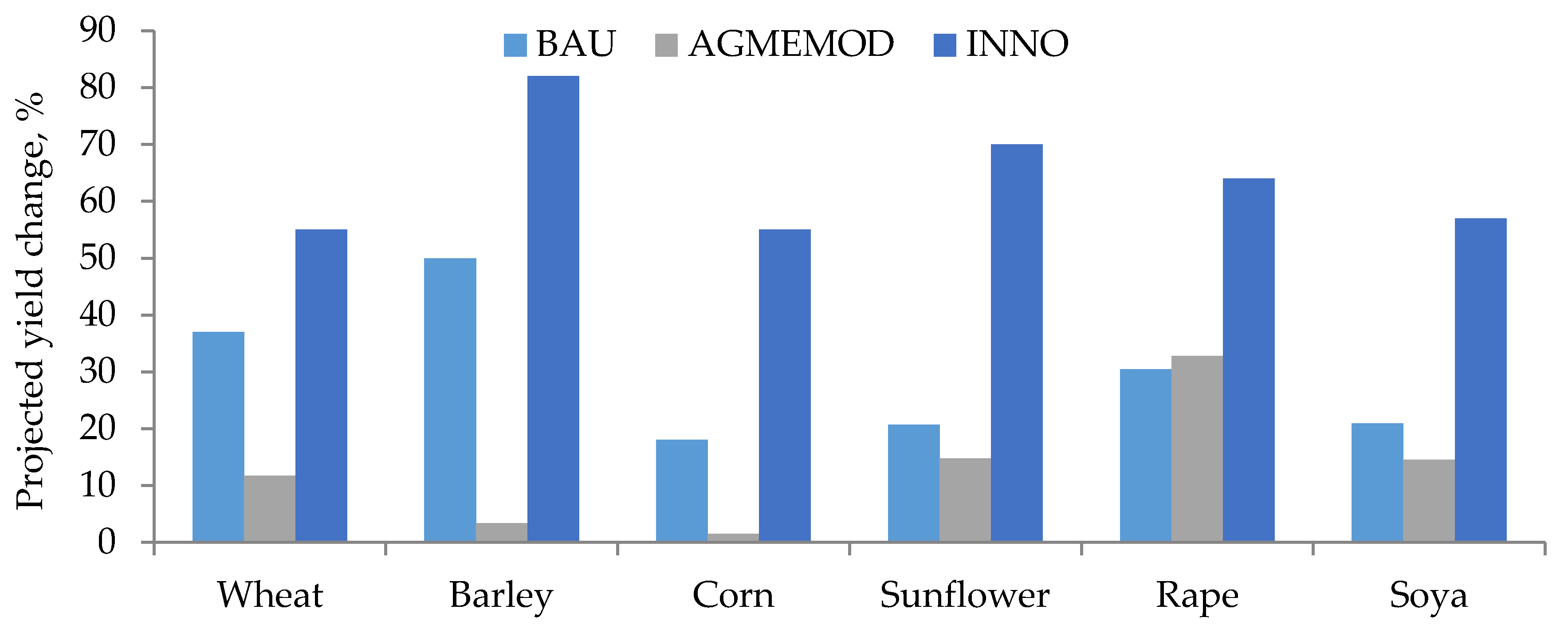
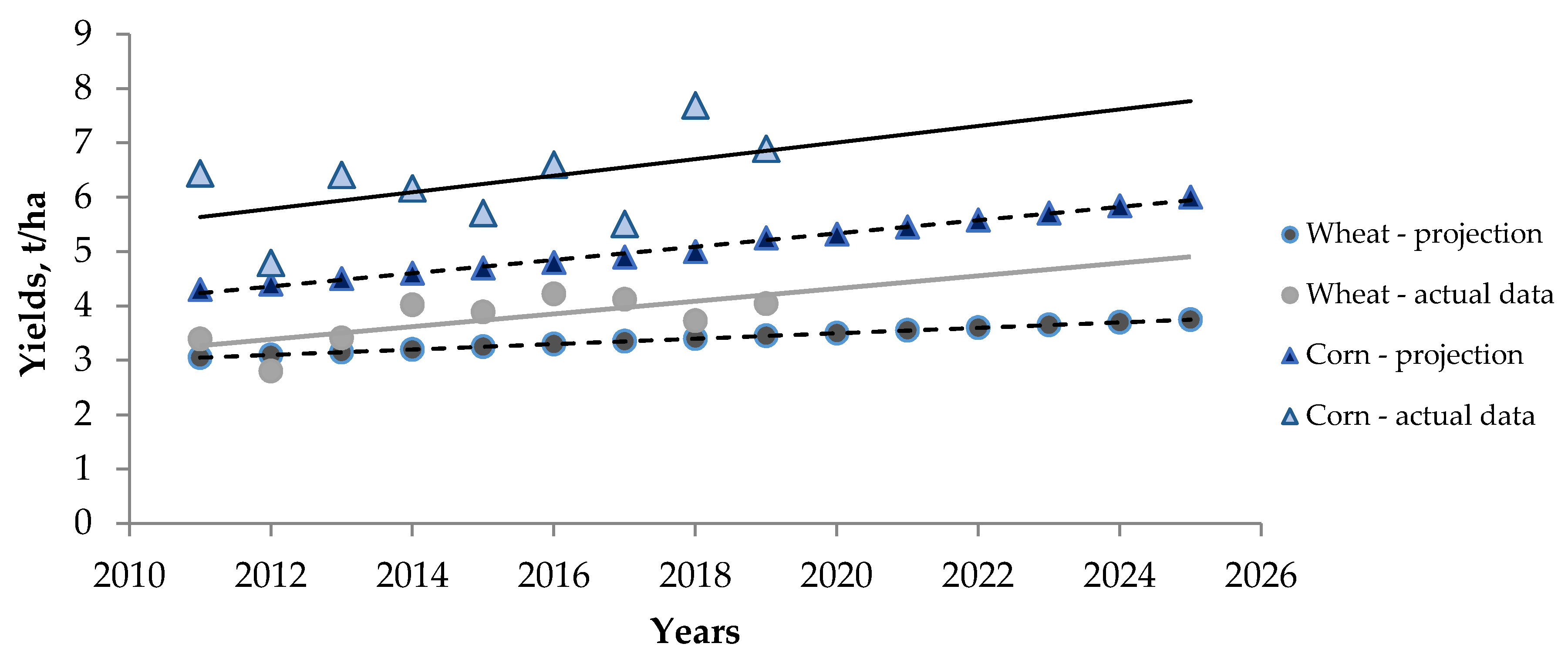
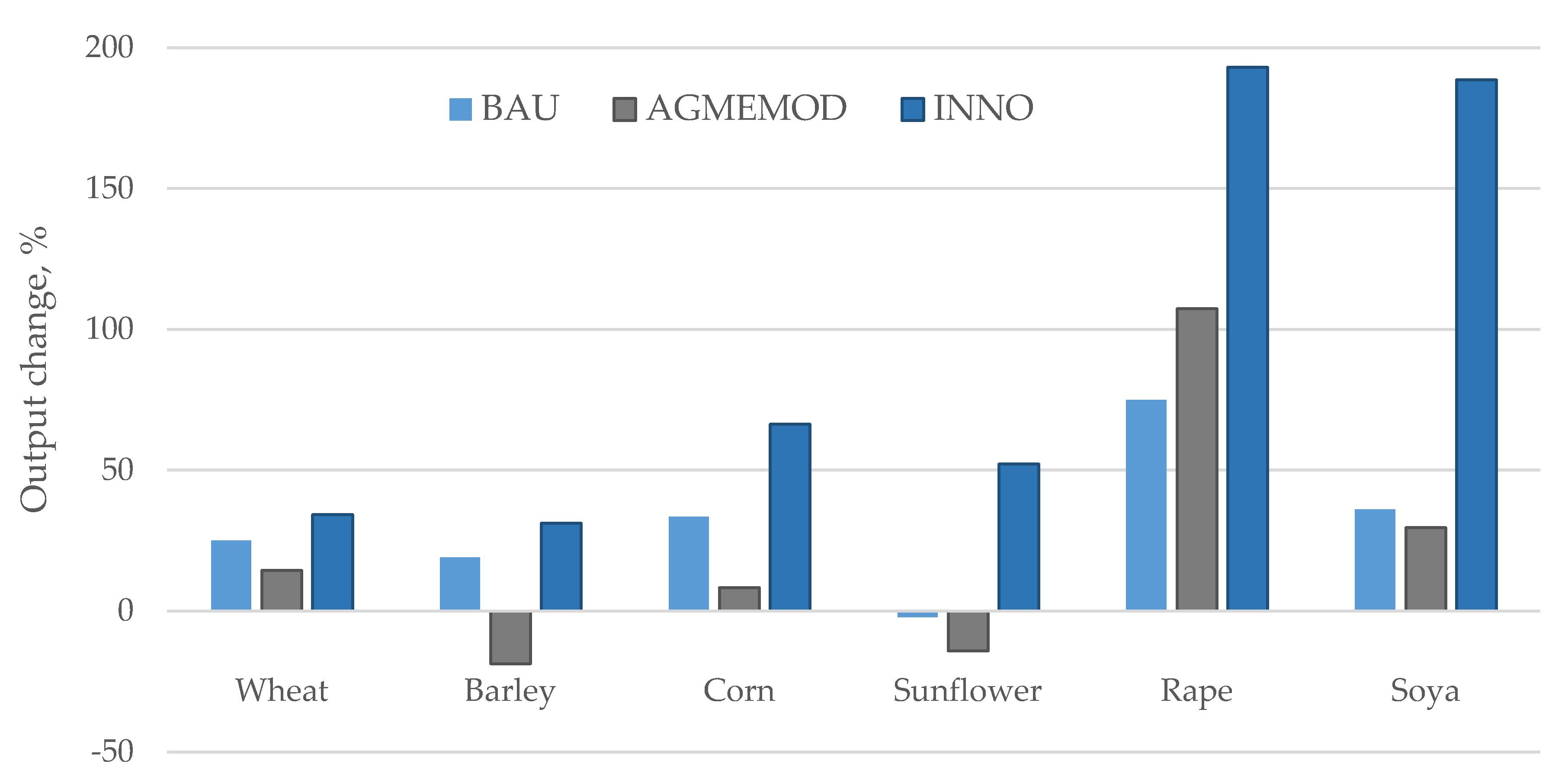
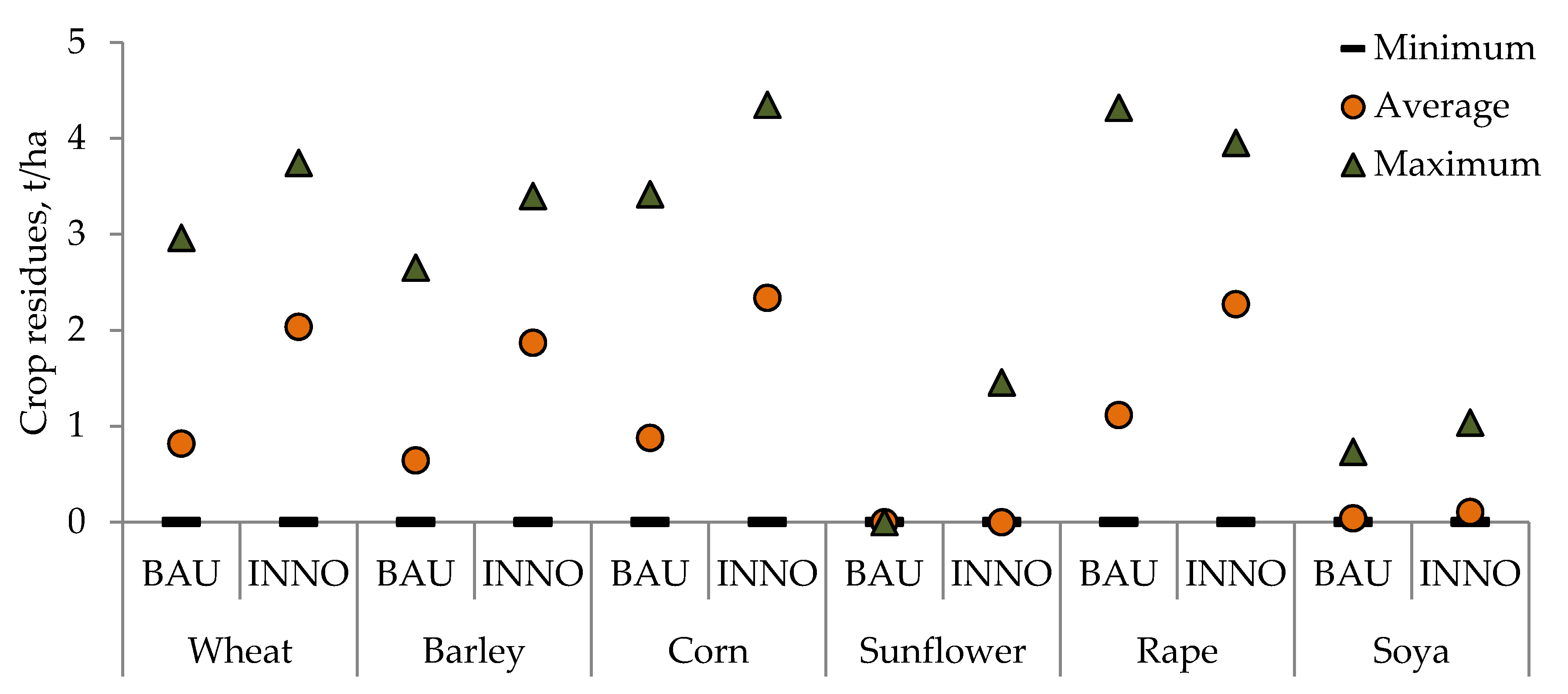
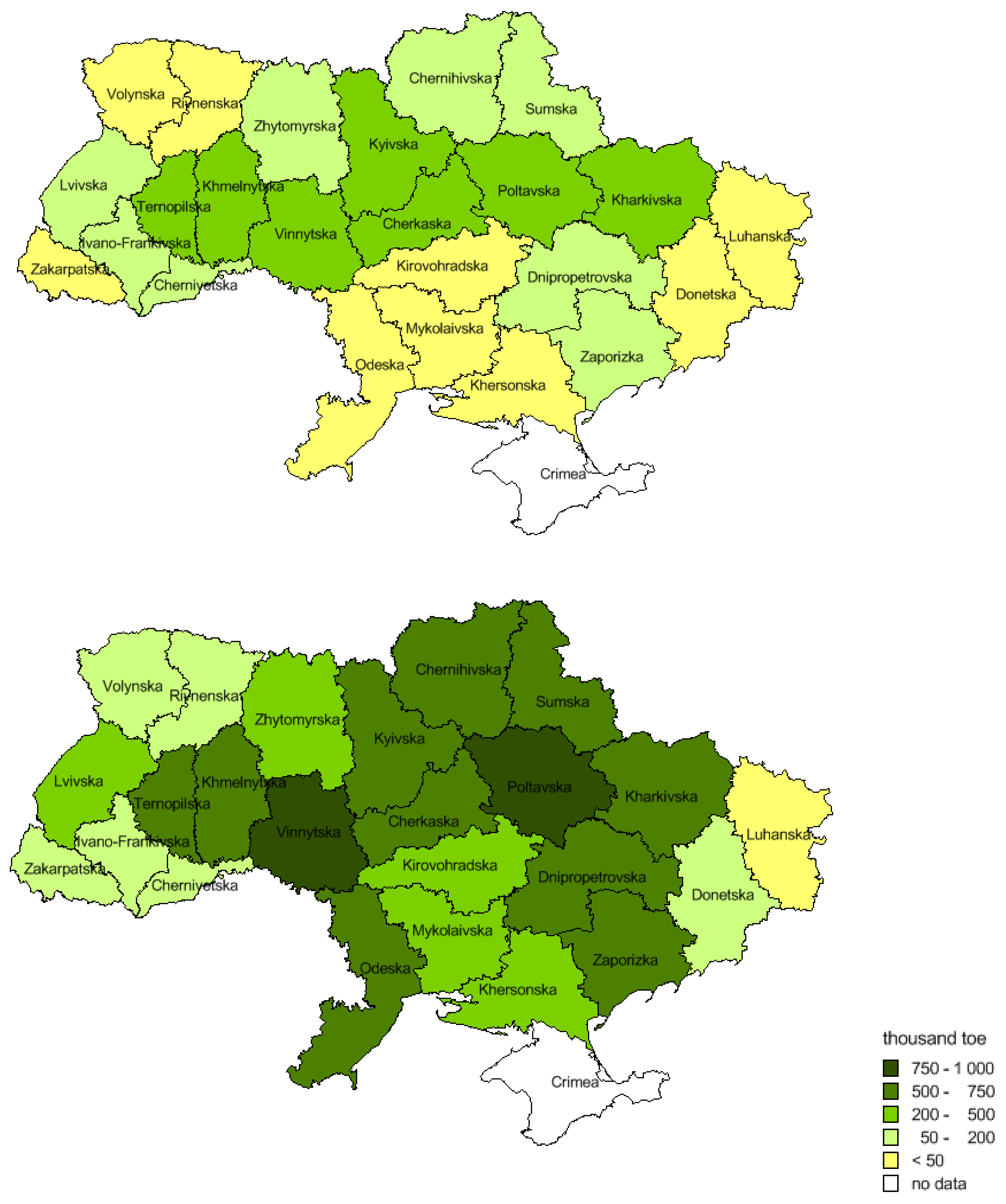
| Crops | Approach 1: Fixed RPR | Approach 2: | ||
|---|---|---|---|---|
| Main Crop Yield, Decitons per ha | Crop Residue Dependency on Yield Equation | Yield-Dependent RPR | ||
| Wheat, including: | 1.0 | - | - | - |
| -Winter | - | 10–25 26–40 | y = 1.7x + 3.4 y = 0.8x + 25.9 | 2.0–1.8 1.8–1.4 |
| -Spring | - | 10–20 21–30 | y = 1.3x + 4.2 y = 0.5x + 19.8 | 1.7–1.5 1.5–1.2 |
| Barley | 0.8 | 10–20 21–35 | y = 0.9x + 6.5 y = 0.9x + 7.2 | 1.5–1.2 1.2–1.1 |
| Corn | 1.3 | 10–35 36–110 | y = 1.2x + 17.5 y = 0.95x + 25.95 | 3.0–1.7 1.7–1.2 |
| Sunflower | 1.9 | 8–30 31–40 | y = 1.8x + 5.3 y = 1.1x + 24.7 | 2.5–2.0 1.9–1.7 |
| Rape | - | 5–15 16–30 | y = 1.7x + 4.7 y = 0.79x + 18.43 | 2.6–2.0 1.9–1.4 |
| Soya | 0.9 | 5–15 16–30 | y = 1.7x + 4.7 y = 0.8x + 18.4 | 2.6–2.0 2.0–1.4 |
| Area Type and Crops | Area, Thousand ha | Change | ||
|---|---|---|---|---|
| 2004 | 2017 | Thousand ha | % | |
| Agricultural area, including: | 35,819 | 34,958 | −861 | −2.4 |
| Sown area, including: | 25,952 | 27,434 | 1482 | 5.7 |
| Cereals and leguminous, including: | 14,887 | 14,607 | −280 | −1.9 |
| Wheat | 5357 | 6368 | 1011 | 18.9 |
| Barley | 4492 | 2506 | −1986 | −44.2 |
| Corn | 2462 | 4522 | 2061 | 83.7 |
| Rye | 732 | 168 | −564 | −77.0 |
| Industrial crops, including: | 4891 | 9161 | 4270 | 87.3 |
| Rape | 113 | 789 | 676 | 598.3 |
| Sunflower | 3486 | 5943 | 2457 | 70.5 |
| Soya | 269 | 1994 | 1725 | 641.3 |
| Sugar beet | 732 | 318 | −414 | −56.6 |
| Fodder crops | 4128 | 1826 | −2303 | −55.8 |
| Crops | BAU | INNO | ||
|---|---|---|---|---|
| Wheat | 10,850 | 15,249 | 11,645 | 14,824 |
| Barley | 3390 | 3962 | 3736 | 5618 |
| Corn | 11,892 | 13,262 | 14,812 | 13,137 |
| Sunflower | 5214 | 6022 | 7823 | 7983 |
| Rape | 3039 | 3667 | 4712 | 5780 |
| Soya | 1061 | 3035 | 2096 | 5071 |
| Total | 35,446 | 45,197 | 44,824 | 52,413 |
| Regions | Wheat | Barley | Corn | |||||||||
|---|---|---|---|---|---|---|---|---|---|---|---|---|
| N | P | K | H | N | P | K | H | N | P | K | H | |
| Vinnytska | 1.8 | −18.9 | −33.1 | 0.68 | −9.4 | −15.7 | −30.9 | 0.38 | −14.2 | −20.6 | −61.6 | 0.33 |
| Volynska | 24.7 | −3.6 | 8.8 | 0.78 | 1.5 | 5.2 | 16.8 | 0.32 | −28.9 | −13.0 | −29.9 | 0.89 |
| Dnipropetrovska | −2.1 | −10.4 | −16.3 | −0.07 | −6.8 | 0.1 | −9.4 | −0.37 | −3.8 | 0.1 | −28.4 | −1.06 |
| Donetska | −16.5 | −18.6 | −26.1 | −0.04 | −17.2 | −2.8 | −15.0 | −0.35 | −3.8 | −7.2 | −34.1 | −1.28 |
| Zhytomyrska | 6.2 | −11.8 | −7.1 | 0.60 | 7.1 | −5.7 | 2.5 | 0.26 | −32.0 | −22.5 | −51.3 | 0.44 |
| Zakarpatska | 42.9 | −8.0 | −6.0 | 0.37 | 37.2 | 10.1 | 12.9 | 0.15 | 36.4 | −25.7 | −50.8 | 0.07 |
| Zaporizka | 12.5 | −4.8 | −14.5 | −0.01 | −8.2 | −1.4 | −11.4 | −0.25 | −1.4 | 2.0 | −23.1 | −0.80 |
| Ivano-Frankivska | 22.3 | −10.5 | 3.7 | 0.76 | −7.7 | −4.9 | −4.4 | 0.37 | −9.7 | −9.4 | −39.8 | −0.24 |
| Kyivska | 29.0 | −3.6 | 4.9 | 0.06 | 8.3 | 1.4 | 12.8 | −0.06 | 4.4 | −4.7 | −29.7 | −0.32 |
| Kirovohradska | 1.7 | −9.4 | −15.5 | −0.25 | −9.9 | 1.2 | −7.9 | −0.49 | −10.4 | −6.6 | −34.5 | −1.11 |
| Luhanska | −23.7 | −15.8 | −32.7 | 0.06 | −23.4 | −7.9 | −24.6 | −0.36 | −9.5 | −9.6 | −35.8 | −1.20 |
| Lvivska | 18.2 | −12.2 | −8.7 | 0.62 | −16.3 | −18.6 | −9.3 | 0.49 | −12.7 | −0.6 | −46.9 | −0.10 |
| Mykolaivska | −5.3 | −5.9 | −16.7 | 0.10 | −11.7 | −1.4 | −12.5 | −0.17 | −1.3 | 11.6 | −31.1 | −0.71 |
| Odeska | 5.6 | −1.7 | −17.2 | 0.37 | −10.1 | −1.7 | −14.1 | 0.20 | −4.2 | −5.1 | −34.1 | −0.31 |
| Poltavska | 13.7 | −3.7 | −4.4 | 0.16 | 7.8 | −2.6 | −1.7 | −0.18 | 1.3 | −13.7 | −41.2 | −0.69 |
| Rivnenska | 18.1 | −6.0 | 10.0 | 0.77 | −11.5 | −12.4 | −8.7 | 0.50 | −35.4 | −21.7 | −44.2 | 0.39 |
| Sumska | −13.2 | −12.7 | −7.3 | 0.48 | −6.3 | −3.2 | 6.0 | 0.00 | −23.4 | −22.2 | −56.0 | −0.01 |
| Ternopilska | 23.7 | −13.3 | −4.6 | 0.66 | −12.1 | −18.2 | −8.3 | 0.39 | −13.5 | −26.3 | −61.8 | 0.25 |
| Kharkivska | 7.6 | −9.2 | −18.5 | −0.04 | 2.7 | −3.4 | −10.9 | −0.51 | 26.4 | −2.1 | −28.3 | −1.78 |
| Khersonska | −15.7 | −19.1 | −23.8 | 0.44 | −12.8 | −10.3 | −17.8 | 0.16 | −31.6 | −24.0 | −66.9 | 0.90 |
| Khmelnytska | −5.0 | −18.7 | −12.5 | 0.72 | −18.8 | −16.1 | −9.5 | 0.34 | −34.9 | −25.3 | −64.5 | 0.06 |
| Cherkaska | 27.1 | −6.3 | −3.1 | 0.06 | 15.0 | 3.1 | 11.5 | −0.08 | 1.0 | −8.0 | −34.3 | −0.55 |
| Chernivetska | −6.6 | −13.4 | −10.5 | 1.03 | 3.7 | −13.3 | −12.3 | 0.56 | 8.9 | 1.4 | −24.6 | 0.35 |
| Chernihivska | 6.0 | −7.2 | −0.5 | 0.41 | −2.4 | −4.7 | 8.0 | 0.15 | −14.5 | −18.9 | −52.3 | −0.23 |
| Regions | Soya | Sunflower | Rape | |||||||||
|---|---|---|---|---|---|---|---|---|---|---|---|---|
| N | P | K | H | N | P | K | H | N | P | K | H | |
| Vinnytska | 41.7 | 1.3 | −28.8 | −0.97 | 22.5 | 8.0 | −65.1 | −0.88 | 37.7 | −1.3 | −21.5 | 1.14 |
| Volynska | 40.4 | 3.2 | −19.6 | −0.75 | 12.9 | 18.6 | −33.0 | −0.86 | −2.5 | −12.3 | −30.2 | 1.70 |
| Dnipropetrovska | 30.4 | 10.0 | −20.4 | −1.53 | 1.7 | 10.4 | −48.2 | −1.45 | −23.6 | −17.7 | −53.8 | 0.36 |
| Donetska | 27.4 | 3.5 | −8.1 | −1.93 | 0.7 | 11.0 | −44.9 | −1.63 | −40.2 | −31.0 | −71.0 | 0.37 |
| Zhytomyrska | 36.4 | −6.1 | −33.2 | −0.94 | 22.4 | 9.0 | −42.5 | −1.12 | −16.0 | −13.2 | −44.3 | 1.14 |
| Zakarpatska | 39.1 | −19.1 | −68.6 | −0.33 | 44.5 | 20.6 | −31.7 | −0.97 | 12.4 | −15.1 | −37.8 | 0.65 |
| Zaporizka | 44.8 | 0.8 | −40.0 | −0.82 | 5.7 | 10.0 | −39.5 | −1.29 | −13.8 | −15.6 | −50.4 | 0.36 |
| Ivano-Frankivska | 46.9 | 2.7 | −29.4 | −1.35 | 23.5 | 17.6 | −46.6 | −1.58 | 13.4 | −13.6 | −32.4 | 1.16 |
| Kyivska | 42.4 | 7.1 | −10.2 | −1.41 | 22.5 | 15.9 | −34.6 | −1.37 | 11.1 | −12.9 | −32.9 | 0.70 |
| Kirovohradska | 24.3 | 1.2 | −20.4 | −1.78 | −1.6 | 11.5 | −47.8 | −1.68 | −30.5 | −17.5 | −54.7 | 0.17 |
| Luhanska | 10.9 | −10.1 | −26.6 | −1.63 | −12.2 | 2.5 | −54.8 | −1.41 | −29.2 | −20.4 | −62.2 | 0.29 |
| Lvivska | 46.5 | 1.9 | −30.0 | −1.36 | 25.7 | 7.8 | −40.4 | −1.59 | 9.3 | −19.5 | −54.9 | 1.13 |
| Mykolaivska | 32.5 | −1.4 | −26.2 | −1.16 | 1.6 | 10.2 | −43.5 | −1.13 | −32.0 | −2.0 | −55.2 | 0.43 |
| Odeska | 49.5 | 7.1 | −31.6 | −0.48 | 10.3 | 14.3 | −50.3 | −0.70 | −3.7 | 2.1 | −45.2 | 0.63 |
| Poltavska | 42.3 | 3.6 | −18.2 | −1.60 | 19.8 | 10.7 | −48.6 | −1.45 | −37.3 | −30.0 | −65.2 | 1.03 |
| Rivnenska | 17.5 | −11.0 | −44.1 | −0.80 | 7.5 | 5.3 | −61.5 | −0.92 | −14.0 | −15.2 | −35.6 | 1.68 |
| Sumska | 44.2 | 4.1 | −17.2 | −1.42 | 11.5 | 13.5 | −43.6 | −1.36 | −27.3 | −16.0 | −53.7 | 1.13 |
| Ternopilska | 48.3 | −1.5 | −32.0 | −1.06 | 20.2 | 6.1 | −59.1 | −1.19 | 10.3 | −13.6 | −42.7 | 0.97 |
| Kharkivska | 51.6 | 3.3 | −17.5 | −2.39 | 18.6 | 11.4 | −54.8 | −2.16 | 51.4 | −19.8 | −58.8 | 0.13 |
| Khersonska | 26.5 | −14.0 | −64.3 | 0.10 | 3.6 | 2.0 | −42.4 | −0.54 | −39.9 | −29.5 | −64.5 | 0.89 |
| Khmelnytska | 41.1 | −6.9 | −40.1 | −1.30 | 10.9 | 7.5 | −64.5 | −1.30 | 0.1 | −14.4 | −50.8 | 0.90 |
| Cherkaska | 49.2 | 4.5 | −17.5 | −1.54 | 27.3 | 17.0 | −38.2 | −1.39 | 2.9 | −11.2 | −36.6 | 0.67 |
| Chernivetska | 28.3 | −5.7 | −30.3 | −0.46 | 23.5 | 4.1 | −60.5 | −0.42 | −10.2 | −17.2 | −51.7 | 1.13 |
| Chernihivska | 34.3 | 3.6 | −19.6 | −1.76 | 23.0 | 15.0 | −35.8 | −1.82 | −16.5 | −14.8 | −49.0 | 1.06 |
| Regions | Wheat | Barley | Corn | Soya | Sunflower | Rape | ||||||
|---|---|---|---|---|---|---|---|---|---|---|---|---|
| B | I | B | I | B | I | B | I | B | I | B | I | |
| Vinnytska | 1.21 | 1.52 | 0.85 | 1.06 | 0.81 | 1.61 | −0.60 | 0.05 | −0.70 | 0.04 | 1.23 | 1.88 |
| Volynska | 0.91 | 1.64 | 0.87 | 1.14 | 0.95 | 1.51 | −0.57 | −0.44 | −0.77 | −0.52 | 1.65 | 2.16 |
| Dnipropetrovska | 0.39 | 0.57 | 0.19 | 0.58 | 0.08 | 0.55 | −0.42 | −0.03 | −0.53 | −0.19 | 0.77 | 1.14 |
| Donetska | 0.30 | 0.48 | 0.20 | 0.40 | −0.19 | −0.04 | −0.78 | −0.14 | −0.64 | −0.47 | 0.67 | 1.14 |
| Zhytomyrska | 0.82 | 1.41 | 0.70 | 1.04 | 0.75 | 1.22 | −0.78 | −0.59 | −1.02 | −0.69 | 1.14 | 1.98 |
| Zakarpatska | 0.64 | 1.53 | 0.25 | 0.47 | 0.11 | 0.97 | −0.54 | −0.54 | −0.99 | −0.68 | 0.82 | 2.18 |
| Zaporizka | 0.41 | 0.60 | 0.25 | 0.53 | 0.09 | 0.17 | 0.14 | 0.20 | −0.43 | −0.26 | 0.79 | 1.17 |
| Ivano-Frankivska | 0.91 | 1.47 | 0.54 | 0.82 | 0.19 | 0.30 | −1.11 | −1.12 | −1.36 | −1.25 | 1.41 | 1.93 |
| Kyivska | 1.01 | 1.12 | 0.64 | 0.85 | 0.41 | 1.47 | −0.99 | −0.04 | −1.08 | −0.03 | 1.04 | 1.95 |
| Kirovohradska | 0.47 | 0.63 | 0.16 | 0.47 | −0.57 | 0.83 | −1.36 | −0.15 | −1.46 | −0.20 | 0.28 | 1.30 |
| Luhanska | 0.37 | 0.56 | 0.22 | 0.56 | 0.00 | 0.10 | −0.54 | 0.00 | −0.55 | −0.33 | 0.70 | 1.03 |
| Lvivska | 0.82 | 1.19 | 0.68 | 0.92 | 0.41 | 0.75 | −1.08 | −0.90 | −1.25 | −1.10 | 1.15 | 2.15 |
| Mykolaivska | 0.48 | 0.67 | 0.33 | 0.57 | 0.34 | 0.94 | −0.21 | 0.19 | −0.32 | 0.19 | 0.78 | 1.40 |
| Odeska | 0.62 | 0.79 | 0.51 | 0.70 | 0.39 | 1.01 | 0.12 | 0.31 | −0.21 | 0.26 | 0.83 | 1.16 |
| Poltavska | 0.73 | 1.21 | 0.49 | 0.66 | 0.11 | 1.23 | −1.09 | −0.22 | −1.13 | −0.21 | 0.80 | 1.60 |
| Rivnenska | 1.04 | 1.55 | 0.83 | 1.11 | 0.65 | 1.14 | −0.67 | −0.58 | −0.94 | −0.65 | 1.46 | 2.08 |
| Sumska | 0.59 | 1.06 | 0.24 | 0.47 | 0.17 | 0.74 | −1.10 | −0.86 | −1.21 | −0.92 | 0.61 | 1.24 |
| Ternopilska | 0.81 | 1.09 | 0.48 | 0.73 | 0.39 | 0.78 | −0.93 | −0.87 | −1.12 | −0.89 | 1.13 | 1.64 |
| Kharkivska | 0.63 | 0.85 | 0.22 | 0.61 | −0.99 | 0.66 | −1.85 | −0.43 | −1.72 | −0.41 | 0.07 | 1.38 |
| Khersonska | 0.70 | 0.84 | 0.43 | 1.00 | 1.34 | 1.45 | 0.62 | 0.59 | −0.15 | 0.11 | 0.66 | 1.27 |
| Khmelnytska | 1.26 | 1.38 | 0.94 | 1.08 | 0.41 | 1.53 | −0.94 | −0.08 | −1.03 | −0.11 | 1.07 | 1.70 |
| Cherkaska | 1.05 | 1.31 | 0.64 | 0.80 | 0.35 | 1.55 | −1.12 | −0.09 | −1.05 | −0.11 | 1.00 | 1.82 |
| Chernivetska | 1.25 | 1.39 | 0.49 | 0.65 | 0.55 | 1.28 | −0.23 | 0.14 | −0.39 | 0.17 | 1.13 | 1.91 |
| Chernihivska | 0.56 | 1.29 | 0.44 | 0.64 | 0.04 | 0.67 | −1.34 | −1.11 | −1.53 | −1.21 | 0.81 | 1.57 |
| Crops | BAU Scenario | INNO Scenario | ||
|---|---|---|---|---|
| ktoe | % | ktoe | % | |
| Wheat | 1294 | 35.5 | 3892 | 36.3 |
| Barley | 442 | 12.1 | 1655 | 15.4 |
| Corn | 1257 | 34.5 | 3172 | 29.6 |
| Sunflower | 21 | 0.6 | 87 | 0.8 |
| Rape | 0 | 0.0 | 342 | 3.2 |
| Soya | 629 | 17.3 | 1575 | 14.7 |
| Total | 3634 | 100.0 | 10,723 | 100.0 |
© 2020 by the authors. Licensee MDPI, Basel, Switzerland. This article is an open access article distributed under the terms and conditions of the Creative Commons Attribution (CC BY) license (http://creativecommons.org/licenses/by/4.0/).
Share and Cite
Kyryzyuk, S.; Krupin, V.; Borodina, O.; Wąs, A. Crop Residue Removal: Assessment of Future Bioenergy Generation Potential and Agro-Environmental Limitations Based on a Case Study of Ukraine. Energies 2020, 13, 5343. https://doi.org/10.3390/en13205343
Kyryzyuk S, Krupin V, Borodina O, Wąs A. Crop Residue Removal: Assessment of Future Bioenergy Generation Potential and Agro-Environmental Limitations Based on a Case Study of Ukraine. Energies. 2020; 13(20):5343. https://doi.org/10.3390/en13205343
Chicago/Turabian StyleKyryzyuk, Sergii, Vitaliy Krupin, Olena Borodina, and Adam Wąs. 2020. "Crop Residue Removal: Assessment of Future Bioenergy Generation Potential and Agro-Environmental Limitations Based on a Case Study of Ukraine" Energies 13, no. 20: 5343. https://doi.org/10.3390/en13205343
APA StyleKyryzyuk, S., Krupin, V., Borodina, O., & Wąs, A. (2020). Crop Residue Removal: Assessment of Future Bioenergy Generation Potential and Agro-Environmental Limitations Based on a Case Study of Ukraine. Energies, 13(20), 5343. https://doi.org/10.3390/en13205343







